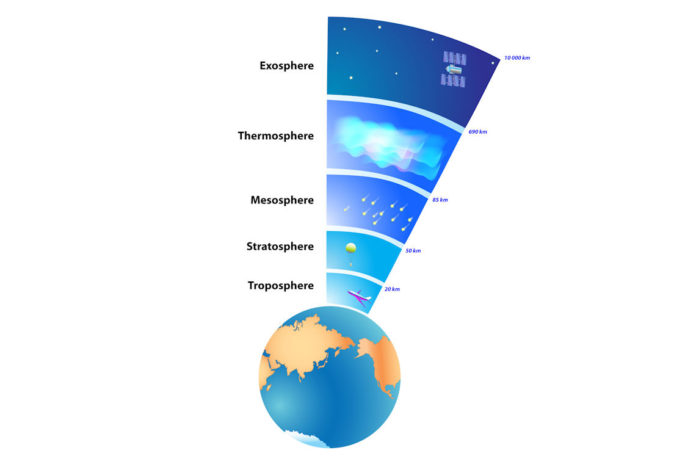The atmosphere is the layer of gas that covers the Earth’s surface. It is an active layer that makes life possible on Earth.
Composition of the Atmosphere
Composition refers to the basic materials that make up the atmosphere.
Nitrogen, Oxygen and Argon
This layer of gas is made up of nitrogen (78%) and oxygen (21%). Argon is also present. Argon is found is small quantities (1%). Oxygen is the most important of these three gases. Oxygen is needed by animal life for respiration.
Carbon Dioxide
This gas is found in tiny quantities (0.04%). However, it is an important gas. Plants need carbon dioxide for photosynthesis. Photosynthesis converts sunlight into food for animal life.
Water Vapor
Water in a gas form (up to 1%) is also present in the atmosphere. It is the source of water that is part of the Earth’s water cycle. Water is necessary for both plant and animal life.
Structure of the Atmosphere
The structure of the atmosphere refers to its different layers. There are five layers of the atmosphere. Each layer differs in air temperature, pressure and composition. These different layers in the atmosphere are important for human life.
Troposphere
The lowest layer in the structure of the atmosphere is the troposphere. This is the layer that we live in. The troposphere is about 17 kilometers thick. As one goes higher into the troposphere the air temperature decreases. Air pressure also decreases as you go higher.
About 80% of all the matter that makes up the atmosphere is located in the troposphere. The tropopause is the boundary between the troposphere and the stratosphere.
Stratosphere
The next layer in the atmosphere is the stratosphere. The stratosphere lies between 12 and 50 kilometers above the earth’s surface. Unlike the troposphere, as you go higher into the stratosphere, the temperature increases.
However, air pressure continues to decrease as you go higher. The air pressure in the stratosphere is much less than in the troposphere. The stratopause is the boundary between the stratosphere and the mesosphere.
The ozone layer is found at the top of the stratosphere. The ozone layer captures ultraviolet rays from the sun. Without the ozone layer, the ultraviolet rays would be too strong for life on the earth.
Mesosphere
The third layer in the atmosphere is the mesosphere. The mesosphere lies between 50 and 85 kilometers above the earth’s surface. The mesosphere is like the troposphere. As you move higher into the mesosphere, the temperature decreases.
The air pressure decreases as elevation gets higher. The mesopause is the boundary between the mesosphere and thermosphere.
Thermosphere
The atmosphere’s fourth layer is the thermosphere. The thermosphere is located between 85 and 600 kilometers above the earth. Like the stratosphere, the temperature increases with elevation. It gets warmer because the thermosphere absorbs energy from the sun. However, because the thermosphere is so thin, it would still feel cold.
The air pressure decreases as the elevation gets higher. The thermopause is the boundary between the thermosphere and exosphere.
Exosphere
The last layer in atmospheric structure is the exosphere. It is the region more than 600 kilometers above the earth. In this layer, air is very thin and gradually becomes more like outer space. This layer represents the change from the earth’s atmosphere to outer space.
Atmosphere, Weather and Climate
Weather
The weather refers to the state of the atmosphere at one point in time. The weather is determined by the air temperature (energy), humidity (water vapor), precipitation (rainfall), and air movements (wind).
Climate
Climate refers to atmospheric conditions over a year. Climatic conditions are affected by changes in air temperatures and rainfall throughout the year.
Reflections
Vocabulary
- climate
- composition
- structure
Notes
- Atmospheric composition is mostly nitrogen, oxygen, argon, carbon dioxide, and water vapor.
- Five layers make up the planet’s gas layer. These layers are the troposphere, stratosphere, mesosphere, thermosphere, and exosphere.
- Atmospheric conditions determine the weather and climate.
Bibliography
- An Atmosphere Study Guide
- Atmospheric Structure, Albany.edu.

